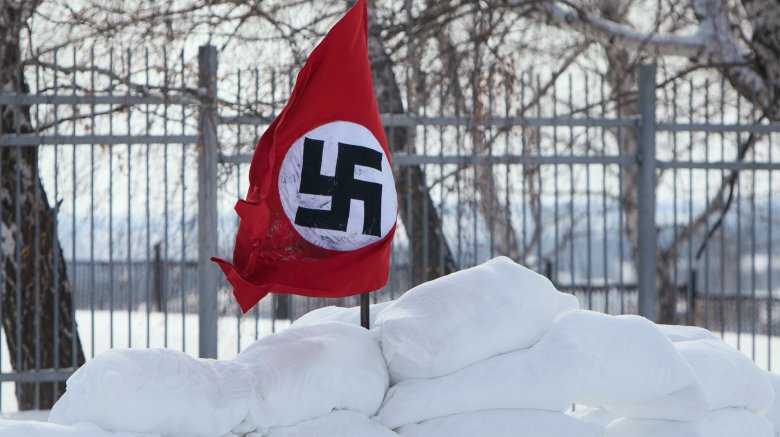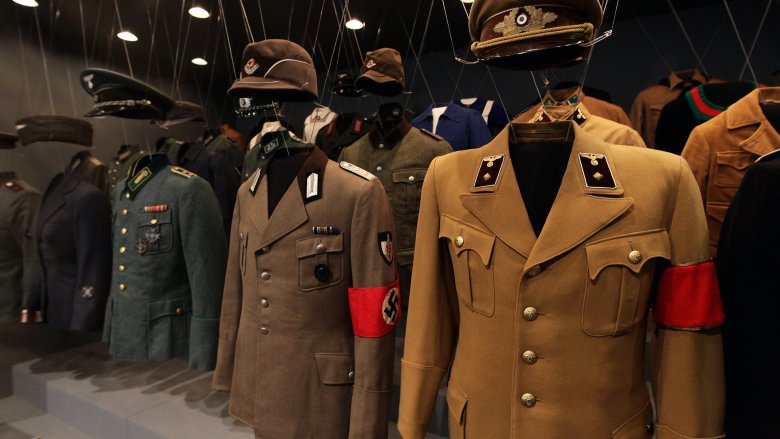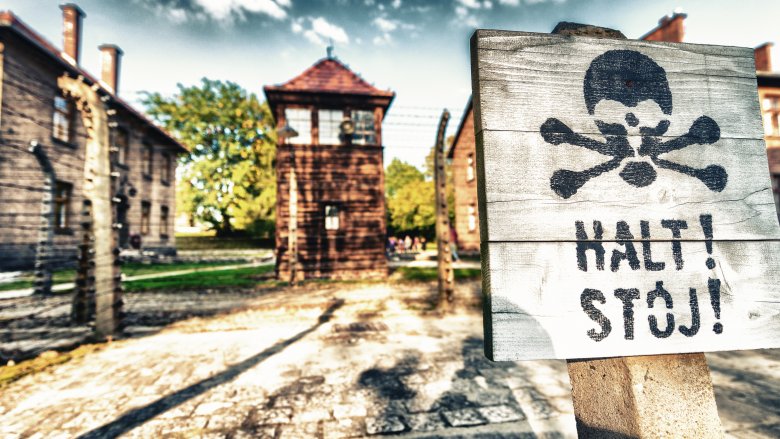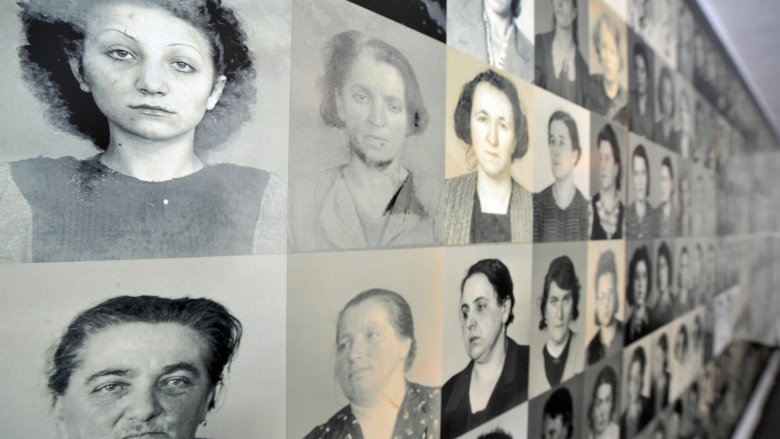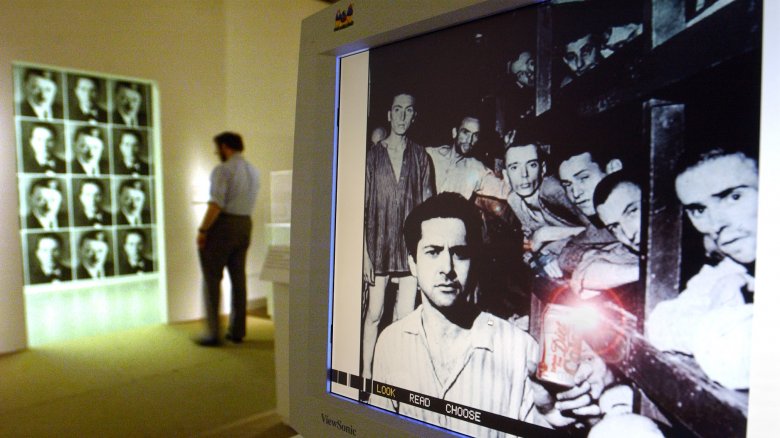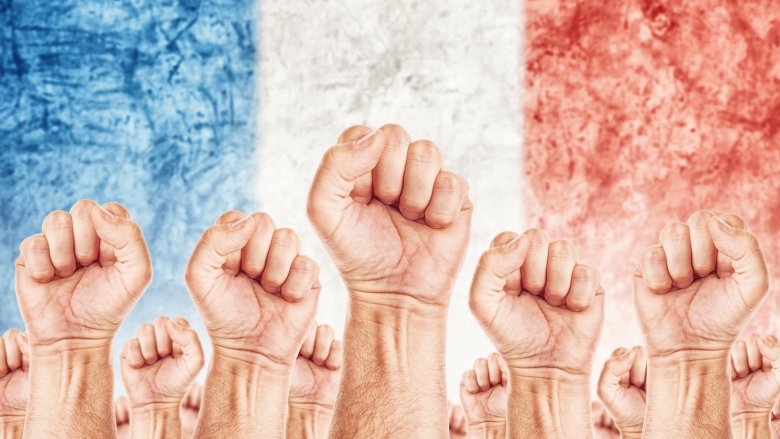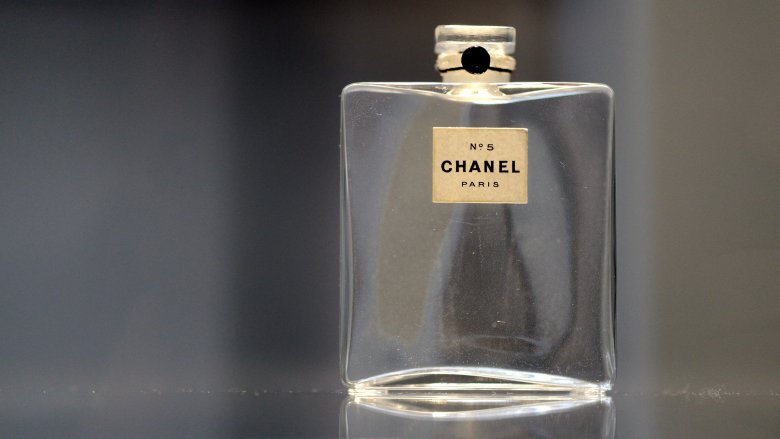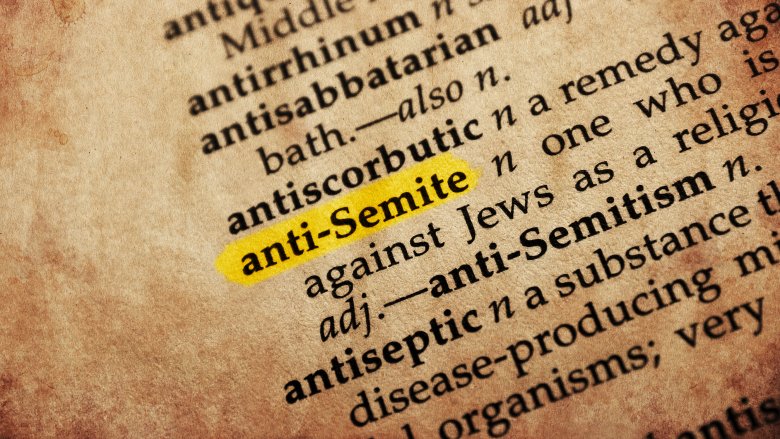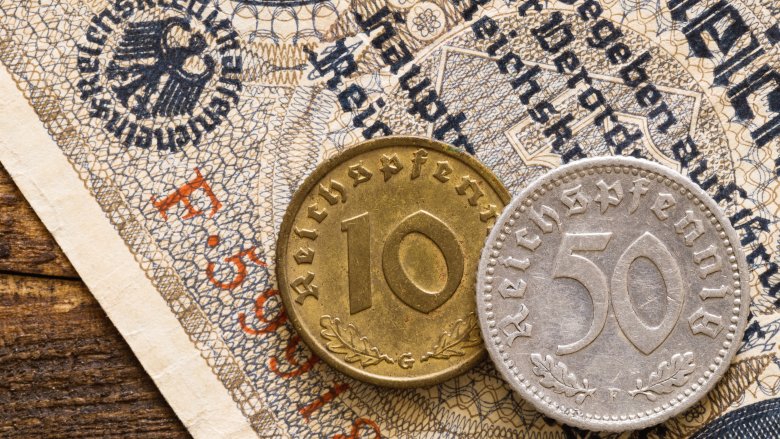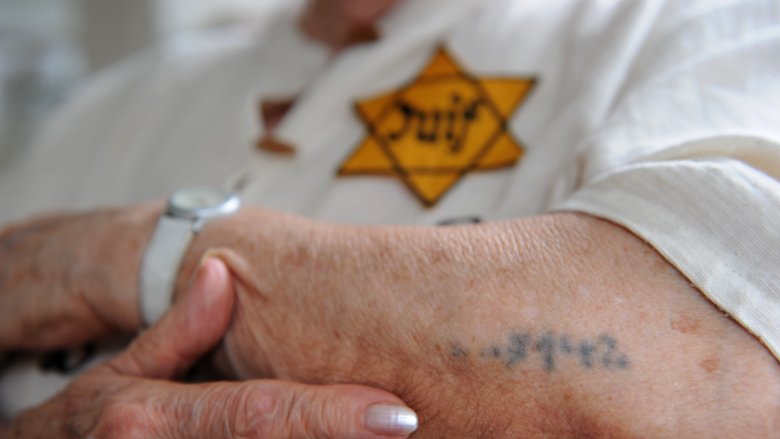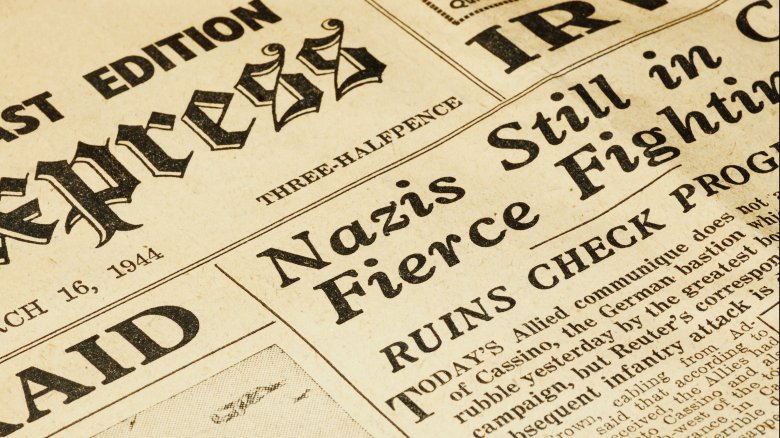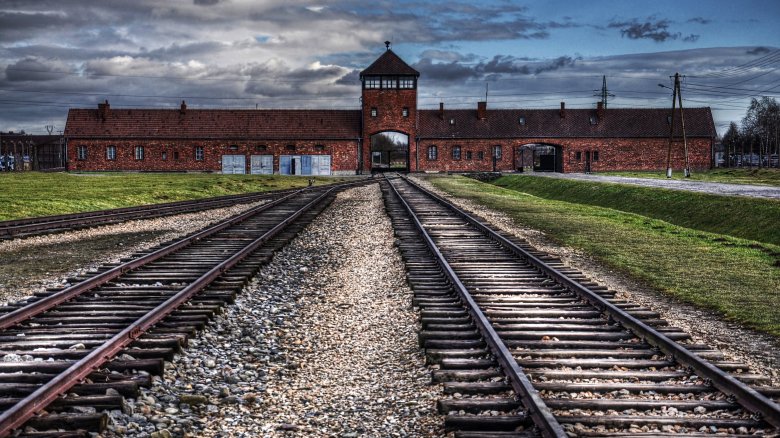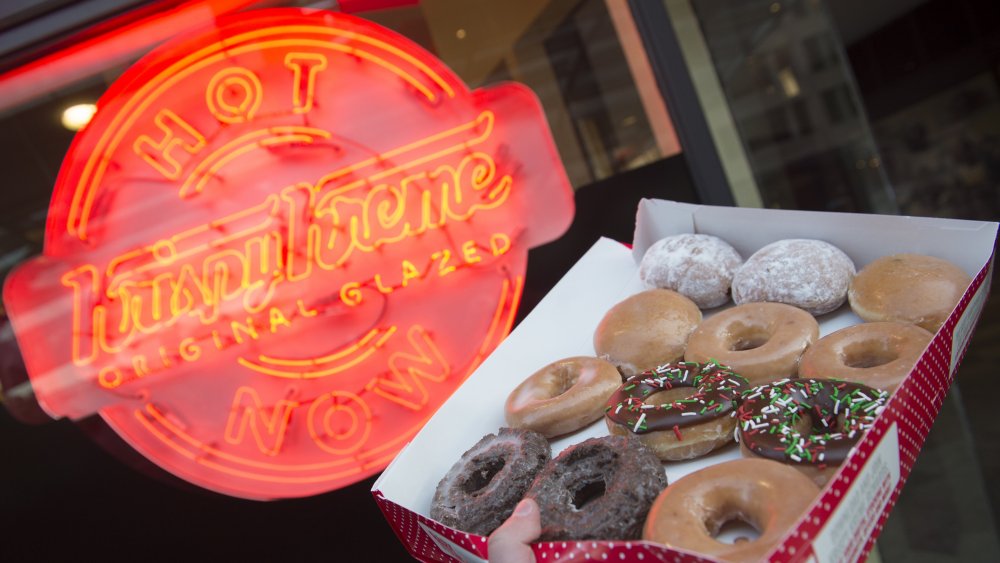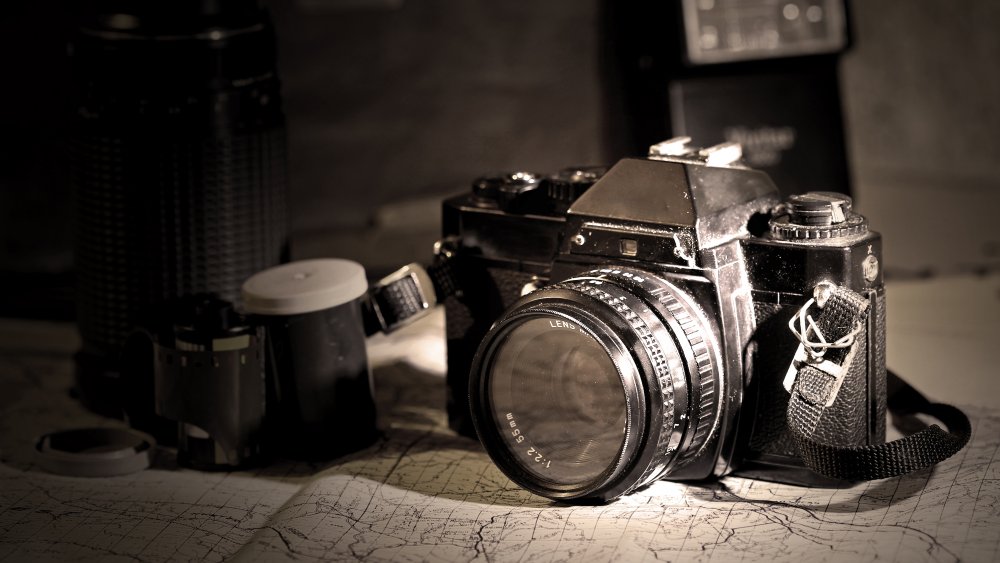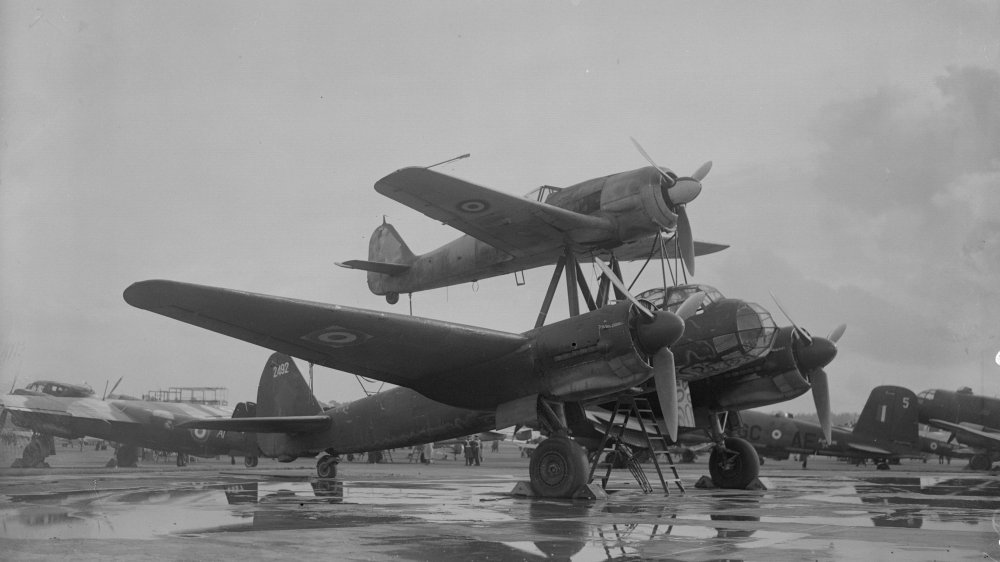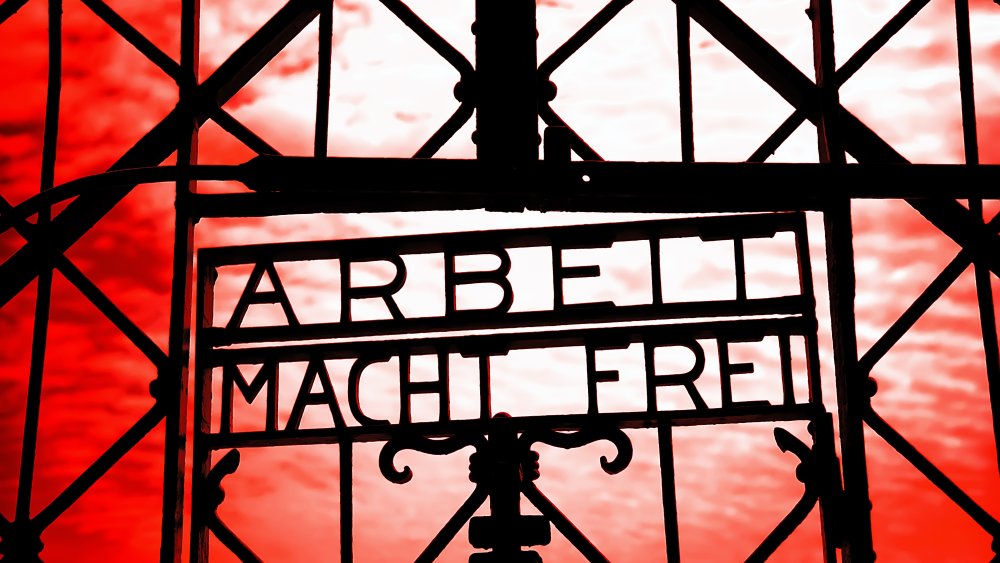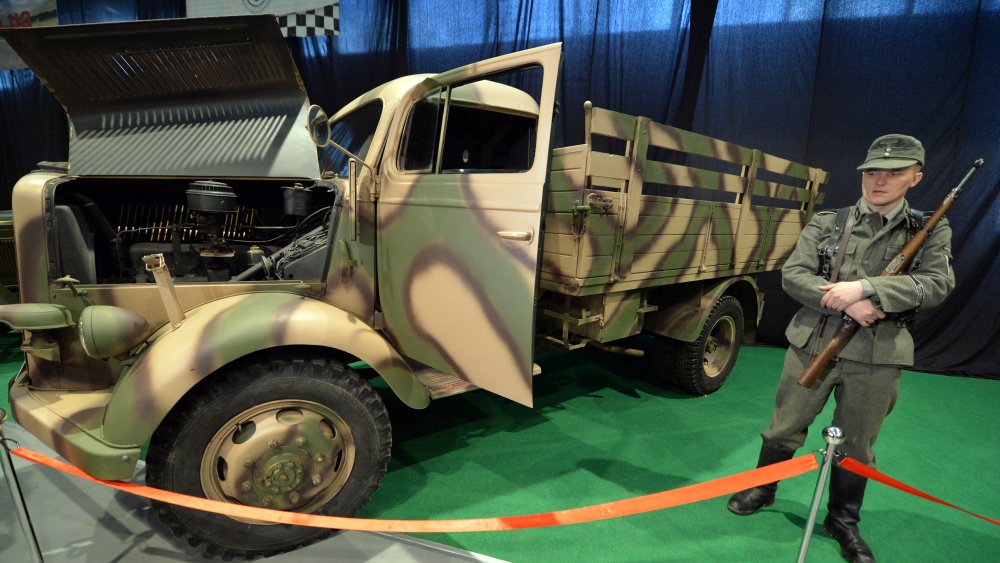Companies With Ties To Nazi Germany
We may receive a commission on purchases made from links.
World War II came to an end with Japan's unconditional surrender. The date was September 2, 1945, and it was six years and a day since Germany's invasion of Poland. Around 78 million people were dead, not even including the unthinkable 6 million who died in Nazi concentration camps. After all that, it took just 18 minutes for the papers to be signed.
The world would never be the same, but for some at least, life went on. The survivors were set to the monumental task of picking up the pieces. While everyday people had to grapple with new realities and the losses of loved ones, some Nazi-aligned businesses simply had to adjust their marketing campaigns. A few of the companies built on the shoulders of the Third Reich not only survived — they flourished. In fact, you probably have some of their products in your home right now, even if you aren't a Nazi enthusiast.
Hugo Boss: Defining Nazi fashion sense
Nazi uniforms are among the most recognizable of all military uniforms, even decades after the war. There's a reason they were such snappy dressers, and that's because they had Hugo Boss doing all their fashion design.
The company issued a formal apology in 1997 (via the New York Times), after the release of its war-era financial records. The discovery of Swiss bank accounts prompted executives to do a deep-dive into their own history, and DW later reported historians found Hugo himself had designed and manufactured the uniforms for the Waffen SS, the SA, the Wehrmacht, and the Hitler Youth, and was the designer for all standard-issue work clothing. It gets worse. When Boss needed to increase production, he did it by importing forced labor from France and Poland.
Historians also found Boss wasn't just following orders. According to Roman Koster of Munich's Bundeswehr University, "It's clear that he did not just join the party just out of economic calculation. Instead, one can clearly see that he was a convinced Nazi." Boss officially went through the de-Nazification process and was allowed to keep the company, something his sons freely talked about — once it became public knowledge. The Times quoted Siegfried Boss as saying, "Of course my father belonged to the Nazi Party, but who didn't back then?"
Allianz: Insuring gas chambers
The horrors perpetrated during World War II were bad enough, and after the war, families trying to pick up the pieces of their lives were faced with an uphill battle that lasted decades. When families tried to file claims with German and Italian insurance companies, they were often denied because those executed in concentration camps didn't have death certificates.
In 1998, the New York Times reported on some recently uncovered evidence that would be damning for Allianz. The documents showed that Allianz AG worked hand in hand with the Nazis, blocked claims from Jewish policy-holders, and even turned policy proceeds over to the Third Reich instead of the actual beneficiaries. It wasn't just a business partnership, either. Several Allianz big-wigs talked to Allied investigators post-war because they had to explain the photos of them hanging out with Hitler. One — Kurt Schmitt — went from Allianz CEO to a new wartime position: Hitler's minister of economics.
Jewish property-holders weren't the only ones Allianz insured. They also insured the production sites at Nazi concentration camps. Those documents showed up in 1997 (via The Jewish News), and they included paperwork written by Allianz officials during site visits. One representative visited Auschwitz in 1942, and reported, "Due to constant military surveillance, there is impeccable order and sanitary conditions."
Siemens: Sourcing labor from concentration camps
Siemens is one of the giants of the electronics world, and it has been for a long time. In 1998, it announced (via the LA Times) it was setting aside $12 million for paying a debt that money just can't fix: using slave labor sourced from concentration camps.
Author and historian Sarah Helm wrote Ravensbruck: Life and Death in Hitler's Concentration Camp for Women (via The New Yorker), and this is where Siemens comes into the tale. Ravensbruck was a slightly different kind of horrible set up for the women the Third Reich deemed unworthy of life. It was on the outskirts of Ravensbruck that Siemens built a factory for the construction of electrical components. There were two separate, 12-hour shifts, each worked by 600 women from the camp. Tuberculosis, boils, diarrhea, and starvation were common, and when they reached the end of their working lives, women were killed. (The photo above shows some of the women who died in Ravensbruck.)
All that makes Siemens' 2002 misstep (via the BBC) that much worse. That's when it tried to trademark the name "Zyklon," which you might recognize as the poisonous gas used in those same concentration camps. It was slated to be the name of a new home goods line — home goods that included gas-fueled ovens. It was withdrawn.
Coca-Cola: Do you want a Fanta?
German infatuation with Coca-Cola started in 1933. That's when Coke's German branch, Coca-Cola GmbH, was taken over by a man named Max Keith. He wanted Coke to be successful, so he kicked off a marketing scheme that tied the drink to everyday German life and the rising star that was the Third Reich. American Coke didn't see anything wrong with it at the time, says Atlas Obscura, and Coke GmbH went ahead and threw a party honoring its 10th birthday and Hitler's 50th.
It wasn't until the 1941 bombing of Pearl Harbor that Coke finally decided it should probably not be associated with the Nazis anymore. The U.S. stopped trading with Germany, which meant no more super-secret cola syrup was going to be imported.
Keith turned to his chemists, who put together their own secret recipe. Mostly drawn from the byproducts of the nation's food industries, this new soda contained beet pulp, curdled milk, and apple fibers. Yum! They called it Fanta (short for "fantasy"), branded it a nationalistic drink, and it was a major hit ... even in the U.S., where it was introduced as an orange drink in 1955.
Christian Dior: Saving Paris with underground resistance
During World War II, Christian Dior was already a designer, but he was working for a major French company under Lucien Lelong (via Jezebel). When Paris fell to the Nazi advance, Lelong was at the head of a group of artists and designers who stood their ground and saved thousands.
It started in 1940, when Nazi officers stormed Lelong's offices and relayed the Fuhrer's demands: The finest Paris design houses were going to be moved to Berlin. Lelong refused, and The Telegraph says he wove an elaborate story of how their artistic ability was so influenced by French culture that moving them would be disastrous. Lelong actually won, fashion stayed in Paris, and around 25,000 women kept their jobs. (Importantly, a huge number of those women were Jewish refugees.)
Now, back to Dior. Christian wasn't the only Dior in Paris at the time, as his sister, Catherine, was also pretty busy. She was courting death daily by working with the French Resistance, until she was arrested and sent to Ravensbruck. She survived, was part of the camp's 1945 liberation, and was awarded the Croix de Guerre. She had her brother's eternal appreciation, too. When he started presenting his post-war fashions, he created a perfume to go along with them. It was 1947, and the perfume was Miss Dior.
Coco Chanel: Collaboration horizontale
During the war years, Coco Chanel definitely hooked up with the Nazi officer Hans Gunther von Dincklage. According to research done by journalist Hal Vaughan (via The New Yorker), there was way more going on there than just a fling.
Newsweek says at the heart is the Wertheimer family, which still controls the Chanel empire. In 1924, Pierre and Paul Wertheimer funded the development of Chanel No. 5, which is one of the perfumes you know of even if you know nothing about perfume. Chanel created it but was bound by a deal that only gave her 10 percent of the profits. World War II rolled around, the Nazis rolled into Paris, and Chanel tried to use them to roll over the deal she'd made to get a better one. Her attempts at using Aryan law failed, though, mostly because the Wertheimers transferred the company into the name of a Christian friend as a sort of preventative measure.
Lots of other accusations have been leveled at Chanel, too. The Telegraph says archival documents indicate she had an Abwehr identity: She was Agent F-7124, known as Westminster. It's well-known that her association with von Dincklage allowed her free travel and not a small amount of privilege, although how far her recruitment and spying actually went is still pretty unknown.
Bertelsmann AG: Driving the propaganda machine
You might not be familiar with the media conglomerate officially known as Bertelsmann AG, but you know its largest book publishing division: Random House. It started out as a relatively small publisher of Lutheran texts, and only in 2002 did Bertelsmann offer apologies (via the New York Times) for how it had grown into a mass media giant: by making a fortune on Nazi propaganda.
Bertelsmann had originally denied it was part of the Nazi propaganda machine, even claiming it had been closed during the war after being busted publishing books on the Nazis' banned list. But actually, Bertelsmann founding father Heinrich Mohn started out by joining an SS patron's circle and making regular donations to the cause. He got contracts for field editions of popular fiction, destined for the troops, and some of the titles were bone-chilling in their anti-Semitism. The religious texts Bertelsmann had been publishing took a decidedly Nazi-ish turn. The shut-down did really happen, but it was because the company was accused of illegally hoarding paper.
According to the BBC, Bertelsmann published around 19 million books during the war, and did so under the watchful eye of the Propaganda Ministry. To add insult to injury, some of the workers churning out those books were Jews plucked from the forced labor camps.
Chase National Bank: Supporting the Motherland
During the war years it was frowned upon for any U.S. citizen to send aid to Nazi Germany. But where there's a will, there's a way, and when the Nazi War Crimes and Japanese Imperial Government Records Interagency Working Group (via the National Archives) declassified a whole bunch of files in 2004, it also declassified information about a back door propped open by Chase National Bank.
Between 1936 and 1941, around $20 million was raised on U.S. soil for Nazi Germany. (There were a handful of banking institutions involved, but Chase was the biggest name.) Basically, banks sold something called Rueckwanderer Marks to U.S. citizens of German descent. Part of the purchase price would go back to Germany, while U.S.-based banks would take a percentage, too. If it sounds like something the FBI should be interested in, you're right. According to a book written based on the documents, the FBI opened files on every person who purchased the marks. By 1941, there were 7,300 names on the list. They were investigated, and some were arrested when they were found doing things like celebrating Hitler's birthday. Chase pocketed around $1.2 million in commissions for selling the marks for the Third Reich.
IBM: Keeping the timetable of the Holocaust
Every part of the Nazi war machine has a reputation for being nightmarishly efficient, and their organization skills didn't just come from a fanatical devotion to the cause: They also came from IBM. Gizmodo says the beating heart of the Third Reich was Dehomag, IBM's German division, which built the systems that built the Reich.
IBM, the American Statistical Association, and Dehomag were all connected by one person: Friedrich Zahn, president of the Bavarian Statistical Office and member of the SS. He and his associates viewed the identification — and extermination — of the Jews as a fascinating statistical problem, and preached that a complete catalog of the population was necessary. To that end, Dehomag and IBM were contracted for everything from tracking census information to scheduling the trains going to and from the Nazi concentration camps. Historian Edwin Black (via Mic) dove into the war-era documents and found IBM at almost every turn. He says they actively collaborated with their Nazi clients to design exactly what was needed to keep the machine wheels greased, and set up schools to teach the technicians needed to run the machines.
As if that's not disturbing enough, Black does one better. The ID numbers tattooed on concentration camp prisoners weren't random. They matched a punch-card system IBM designed to track them.
The Associated Press: Neutral, or propaganda?
The Associated Press was there covering the rise and fall of Nazi Germany. It's released a complete expose on its activities walking an admittedly fine line during the war years. On one hand, the AP was given some major awards for its dedication to covering every part of the Nazi regime. Given the political climate, it stayed as independent as it could, but some concessions needed to be made.
At the time, law stated AP photographers working in Germany needed to be German citizens, and as such they were subject to all the other rules and regulations of the Nazi regime. Until 1941, the AP took photos, sent thousands to their New York office, and had others seized by the Propaganda Ministry and used to further the Nazi cause. After Pearl Harbor, the AP was kicked out of Nazi Germany in favor of a photo department under a Waffen SS officer named Helmut Laux.
Things got even shadier in 2017, when the Washington Post reported on recently discovered documents showing the AP distributed and published propaganda photographs they got only by making a deal with the SS and Laux. An estimated 10,000 propaganda shots were credited to AP photographers in this way.
Porsche and Volkswagen: The people's cars
The popular belief is that Volkswagen was founded by the Nazis, but Jalopnik says the truth is a lot more complicated. The term "volkswagen" was used for decades before World War II, and the car that would become the Beetle was a sort of hybrid created from cars before it. So, where do Nazis come in?
With Ferdinand Porsche. Porsche would go on to give his name to his own line of sports cars and to design the Beetle (with some help). Also, he was chummy with Hitler. Hitler even kick-started a company called Kraft durch Freude for Porsche. In English the name was the eerie "Strength-through-Joy." Then the war happened, the company folded, and no civilian Beetles were actually ever sold by the Nazi regime.
The "but" comes from Spiegel Online. Porsche was already a well-established engineer by the time Nazis happened, and he first turned down a contract to work for Stalin. He accepted Hitler's 1934 offer, and ironically, Hitler wanted to call that first company the "Porsche Plant." Porsche went on to serve at the head of Hitler's tank commission, but an Allied investigation ultimately decided against charging him with war crimes.
Dr. Oetker: Forced labor and stolen art
Dr. Oetker's foodstuffs are a baking staple, and it wasn't until 2013 the company published a book revealing its Nazi connections. According to DW, war-era patriarch Rudolf-August Oetker was notoriously tight-lipped about what happened during the war, but his son (and successor) decided he and the world needed to know.
The company made some serious donations to the Nazi cause, and Rudolf-August himself volunteered for service with the SS. It was one (of many) companies that used forced labor sourced from concentration camps, and in 2017 something else came out: Part of the family's art collection had come through Nazi hands. That included a portrait by Anthonis van Dyck, which was bought by the Oetkers at auction after being in the possession of Hermann Goering. Oetker announced it was giving the painting back to its rightful owners and would do the same with other wartime artwork.
IG Farben: Manufacturing death
You might have heard that Bayer was involved with Nazi Germany, right? Well, it's complicated. Parent company IG Farben (which was broken into Bayer, BASF, and Hoechst after the war) didn't just contract with the Nazis for labor; it ran its own concentration camp. It was a sub-camp of Auschwitz called Auschwitz III or Monowitz, and according to the Auschwitz-Birkenau Memorial and Museum, IG Farben contracted with the Nazis to build the camp for a steady supply of labor needed for manufacturing fuel and synthetic rubber. The deal was made in 1941, and then-director Otto Ambros wrote, "Our new friendship with the SS is very fruitful."
Among IG Farben's products was Zyklon B, originally developed as a pesticide and ultimately used to kill prisoners at concentration camps across Germany. The Wollheim Memorial says it had been around since the 1880s and wasn't weaponized until 1941 when 250 prisoners and 600 Soviet POWs were executed with it at Auschwitz.
IG Farben's history is a terrifying study of how big business can go hand-in-hand with a government hell-bent on destruction, and the New York Times says that after the war, it was dissolved into the major companies we know today. Farben's cash was kept in a trust permanently described as "in liquidation," a lingering legal entity that survived for decades.
Krispy Kreme/Panera Bread: Illicit love and forced labor
Vice says that the Reimann family is one of the richest in the world. Their company, JAB, has controlling interests in Krispy Kreme, Pret a Manger, Keurig Green Mountain, Einstein Bros. Bagels, Panera, Caribou Coffee, Peet's, and the Dr. Pepper Snapple Group.
Only recently they found that their father, Albert Reimann Jr., was a devoted follower of Hitler and already a married man when he fell in love with their mother, Emilie Landecker. Landecker, says The Irish Times, was half Jewish and lived in constant fear when she found herself working for Reimann and his cleaning products company. The pair had three children, and in 2019, it was two of those children who owned about 45 percent of JAB. They were also the ones who wanted to know the truth about their father, who once wrote to Heinrich Himmler (via The Guardian) to say they were "a purely Aryan family business" and were "unconditional followers of the race theory."
The family factories used slave labor, and physical and sexual abuse was the norm. Conditions were so bad they were reprimanded by local Nazi leaders for mistreatment of their workers, and Landecker's father, Alfred, was murdered by the Nazis. He has since been honored with the family's Alfred Landecker Foundation, a charity dedicated to Holocaust education, funded with an annual endowment of $25 million, in addition to millions more donated to the Conference on Jewish Material Claims Against Germany.
Kodak: Playing both sides
Investigations into the wartime activity of Kodak turned up something surprising — government officials in both the US and Britain advised the company to keep trading with Germany, well into the conflict. They did so through direct control over their branches in neutral Spain, Switzerland, and Portugal, who then in turn conducted regular business with Nazi Germany.
According to The Nation, the amount of trading Kodak did was described as "fairly substantial purchases from enemy territory" by London's American embassy, and by 1941, Kodak had already taken precautions in case the US joined the war. Control of German operations was transferred to trustees, and Hitler's personal economic adviser had such close ties with the company that military intelligence called him a "Kodak Man."
They weren't just selling and trading in film and camera equipment, either. During the war years, their manufacturing base expanded into military hardware, including detonators and triggers. Among the most successful branches was the one in Nazi-occupied Paris, which hauled in so much cash they started investing in real estate. And yes, Kodak plants in Stuttgart and Berlin-Kopenick were staffed by several hundred slave laborers.
Standard Oil (Exxon) : Blocking America's rubber industry
The relationship between Standard Oil and IG Farben dated back to the 1920s, and according to The New York Times, it was an integral part of the construction of the Luftwaffe. Throughout the 1930s, Standard Oil supplied the German military with one thing that they were missing to rebuild after WWI: a gasoline additive called tetraethyl lead. It wasn't a secret, either — they had the US War Department's authorization to trade.
It went even further than that.
According to The New Republic, Standard Oil was responsible for both discouraging other companies from developing a synthetic rubber that could have been invaluable to the war effort, and developing it on their own. In 1938, they put the finishing touches on a synthetic rubber called butyl ... then sent it straight over to IG Farben in Germany. At the same time, they were also working hand-in-hand with the Nazi government to build a refinery specifically for the productions of aircraft fuel, and by 1941, they were providing the fuel for Italian airlines.
International Telephones and Telegraph (ITT): A stake in German aircraft
There's a rumor that International Telephones and Telegraph (ITT) facilitated communications between German submarines through Latin American lines, but The Harvard Crimson says that's just a highly probable rumor. What has been confirmed is that the company owned 28 percent of Focke-Wulf Aircraft, which manufactured the Fw 190 — a fighter that How Stuff Works calls one of the best and most dangerous aircraft of the war.
According to The Jewish Telegraphic Agency, ITT founder Sosthenes Behn made sure he put Nazi men in charge of the board of directors of ITT's German branches, and on that list of names were men like Kurt von Schroeder, future Nazi SS general. ITT's Swiss branch continued trade with Germany even after the US entered the war and even after their European competitors ceased trading, and here's the real kicker: after the end of the war, ITT got $27 million in damages from the US government. For what? Destruction of their Focke-Wulf plants, which the company called "American properties bombed by Allied bombers."
Ford: From the top down
Henry Ford's antisemitism has been well documented; he was, after all, awarded the Grand Cross of the German Eagle from the Nazi regime, and PBS says he even inspired Hitler with his writing. But that's the individual — what about the company?
According to The Telegraph, getting to the bottom of the story has always been difficult, as the man and the company were so intertwined. But according to Holocaust researcher Max Wallace, then-president (and Henry Ford's son) Edsel Ford not only knew and approved of production being done on behalf of the German military, but trade was so extensive he could have been prosecuted for it post-war. (He died in 1943.)
Ford has long claimed to have lost control over their German divisions through the war years, but letters suggest that Ford took German contracts, declined contracts to build engines for the British RAF, and knew that slave labor was being used at its German factories well before America waded into the front lines of the war. The Guardian says Ford has acknowledged the use of slave labor at their Cologne facility (although they claim they had no control once the Nazis seized it), and have also been linked to Auschwitz. Ford's response to the ongoing lawsuits filed over the use of slave labor? "...the statute of limitations on the victims' claims had expired."
General Motors: Moving the Nazi war machine
Historian Edwin Black says (via the Jewish Virtual Library) that it was on May 2, 1934, that the president of GM's Overseas Corporation, James Mooney, went to meet with Hitler. At the heart of the discussion were contracts with Opel, the car manufacturer that GM had purchased in 1929. It was a brilliant business move: about 40 percent of the cars on the road in Germany came from Opel.
Black says that while GM has repeatedly denied actively helping the Nazi regime, they have admitted that they wish they were able to "hit the rewind button and change some of the things Mr. Sloan [GM's then-company chief] thought and said." Because even though it was Mooney who met with Hitler, it was Sloan who made the final decisions. And he decided to form what Black calls "a strategic business relationship."
Opel became one of the largest suppliers of vehicles to the German military, and in 1935, they even agreed to build a new factory at Brandenburg — a facility that would later be converted to an airplane engine plant building parts for the Luftwaffe. By 1938, they were one of Germany's largest employers, they became a member of the National Socialist Motor Corps, and they deliberately obscured their American roots — even as GM remained sole stockholder and operator. When America declared war in 1941, all communications between GM and Opel ended, and GM went on to become a major supplier of the Allies.
